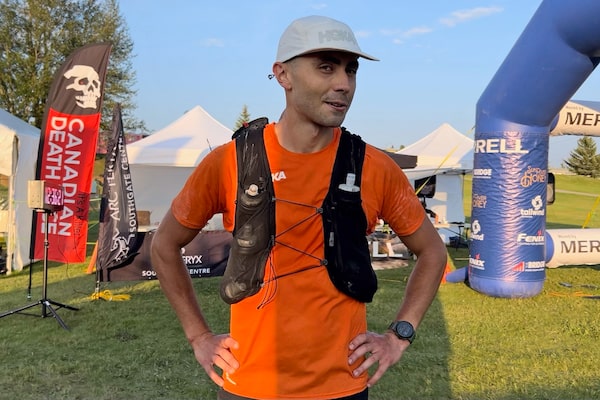
Ihor Verys when he won Canadian Death Race in 2023. Verys won the Barkley Marathons on March 22.Kirsti Dolson/Sinister Sports
When a handful of the world’s best long-distance runners assemble for the start of the Olympic marathon in Paris this August, they’ll be harnessing both body and mind for what is often thought of as a 26.2-mile test of human endurance.
For Ihor Verys, it would be more akin to a scenic tour.
On Friday, the ultramarathoner from Chilliwack, B.C., became the first Canadian to complete the famous – or quite possibly infamous – Barkley Marathons, winning the 100-mile event in 58 hours 44 minutes 59 seconds.
“It’s tough, it’s gnarly, it’s hard … but that’s what ultrarunners love,” Verys wrote on Instagram over the weekend. “We’re in it to challenge ourselves and I think Barkley delivers it more than any other race out there, for sure.”
Taking place in Tennessee’s Frozen Head State Park, the invitation-only race also involves almost 60,000 feet of climbs and descent – about twice the height of Mount Everest.
“In the ultrarunning community this is the trophy race, this is the gold medal,” said Kirsti Dolson, director of customer experience for Sinister Sports, an Alberta company that specializes in ultramarathon events, including the Sinister 7, a 100-mile event won by Verys last year.
“To have Ihor our Canadian ultrarunner win it, to be the first Canadian ever to finish, [we] are just vibrating with excitement right now.”
The fact that Verys finished at all, let alone as the winner, is something of a historic achievement. The Barkley Marathons, which began in 1986, requires participants to complete five loops of 20-plus miles, finding various books located along the course, and tearing out the page corresponding to their bib numbers, using just a map and no GPS technology. All this has to be completed within the cut-off time of 60 hours.
In more than half the races, over almost four decades of existence, there have been no finishers.
“You’ve got all of these challenges like the weather, you’re out there by yourself, you have no GPS, you have to follow a map and navigate for yourself,” said Matthew Shepard, a professional ultrarunner who has competed against Verys, and who also works for Sinister Sports as its manager of field operations.
“And then because it’s so arduous and so long, you’re now running into sleep deprivation. So can you do all these challenging tasks that are challenging individually, can you do them now while your mind is beginning to fail you?”
For sustenance, the athletes take only what they can stuff into their vests and, if they have enough time, can grab something a little more substantial between laps.
“A lot of these guys are able to sit down for maybe five, 10 minutes, have a warm cup of soup or some real food and then they’ve got to get back out there because again, the clock’s ticking,” said Myke LaBelle, owner and race director at Victoria’s Coastline Endurance Running. “It’s an interesting concept, because it’s really like it almost becomes survival rather than actually racing.”
Verys, 29, was born in the Ukrainian city of Chornomorsk, on the shores of the Black Sea. He moved to Manitoba on a student visa in 2015, and took up running as a cheap way to keep his head clear and to alleviate the pressure of being alone in a foreign country. His competitive-racing career began with a modest local 15-kilometre race, and grew from there, with Verys becoming a Canadian citizen along the way.
Like the fog that can sometimes discombobulate runners as they make their way around the unmarked course, the Barkley Marathons are shrouded in mystery. There is something of an inexact science to gaining entry, with many prospective runners having to pen admission letters to put forward the reasons why they should be included.
One way to guarantee access, according to Shepard, is to win some of the big ultraevents on the circuit, such as Big Dog’s Backyard Ultra in Tennessee, a last-man-standing competition where runners must complete a distance of 4.167 miles every hour until they are the last one left on the course.
Shepard thinks that is how Verys might have qualified, when he came second to American Harvey Lewis, whose 108 hours just beat the Canadian’s 107.
Even then, Verys didn’t tell anyone he was going to Barkley. He did drop some hints, however.
“We spoke with a race director in Manitoba the other day, who knows Ihor as well,” Dolson said. “And this race director said, ‘Ihor, what is it that you’re training for? I see that on Strava you’re doing 10,000 metres of elevation a week.’ And Ihor apparently responded to him and said, ‘Oh, I’m just going away on business.’”
The 2024 Barkley Marathons was certainly one for the ages, with an unprecedented five runners finishing. Along with Verys achieving a Canadian first, the race had its first female finisher when British runner Jasmin Paris crossed the line with just 99 seconds to spare in the 60-hour cutoff.
Jasmin Paris finishes the Barkley Marathons with one minute and 39 seconds to spare on March 22.Jacob Zocherman
“The whole running community is excited about Ihor, but possibly even more excited about the fact that a female did finish this race finally,” Dolson said.
The effect that a watershed 2024 event has on the ultramarathon community remains to be seen, but Shepard compares it with another historic running milestone.
“It’ll be amazing to see the four-minute-mile effect,” he said. “Roger Bannister ran the four-minute mile [but before that] it was impossible, they said no way, the human can’t go that fast. And then he did it and then everybody did and now it’s like college standard. And, you know, so a female did it. And now how many are going to follow?”
As for Verys, time is on his side. The Canadian is young to be at the top end of the sport, where most don’t hit their prime until their mid-30s.
“Ihor is coming out of the gate already head and shoulders above everybody else and I can only see him getting stronger from here,” Shepard said.
Editor’s note: This article has been updated to clarify details of the requirement to find books along the race course.
 Paul Attfield
Paul Attfield